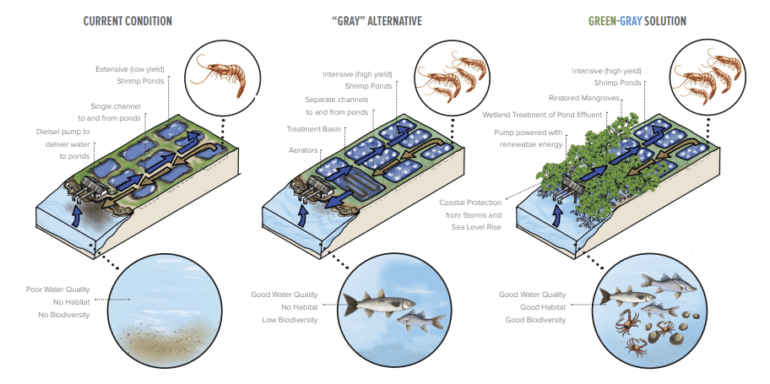TL;DR:
- The diverse team uses AI and earth observation data to identify Climate Smart Shrimp (CSS) sites in Indonesia and the Philippines.
- Shrimp aquaculture has grown dramatically, causing significant mangrove deforestation.
- The Climate Smart Shrimp (CSS) program balances aquaculture intensification with mangrove restoration.
- Machine learning and earth observation data help identify suitable sites for CSS, promoting sustainable practices.
- An interactive web-map tool streamlines CSS implementation and aids conservation decisions.
- CSS projects are expanding rapidly, with plans for global scalability and financial support.
Main AI News:
In an impressive collaboration between academics, conservation practitioners, and tech industry experts, a groundbreaking project has harnessed the power of AI and earth observation data to drive Climate Smart Shrimp (CSS) initiatives in Indonesia and the Philippines. This transformative endeavor, funded through the prestigious 2022 Climate Change AI Innovation Grants program, is spearheaded by Climate Change AI, in conjunction with the Quadrature Climate Foundation, Schmidt Futures, and the Canada Hub of Future Earth.
Over the past four decades, shrimp aquaculture has experienced unprecedented growth, witnessing a staggering 100-fold increase, from an estimated 74,000 metric tons in 1980 to an astounding 7.4 million metric tons in 2020. However, this remarkable expansion has taken its toll on vital coastal ecosystems, particularly mangroves, which have faced severe deforestation. Although deforestation rates have marginally decreased over the years, a staggering 35 percent of global mangroves were lost in the latter half of the twentieth century, leading to the irrevocable loss of critical ecosystem services.
To address this environmental challenge, Conservation International (CI) has spearheaded the innovative Climate Smart Shrimp (CSS) program. This pioneering initiative not only bolsters local livelihoods and enhances food security but also fortifies coastal resilience and aids in adapting to the effects of climate change. By providing small- and medium-sized farmers with resources to sustainably intensify production on a portion of their land, the CSS program incentivizes the restoration of mangroves on the remaining sections. This strategy empowers smaller farms to compete effectively in the global commodity market while simultaneously funding coastal mangrove restoration efforts. Nonetheless, implementing CSS as an approach is contingent upon the suitability of the aquaculture farms.
In a strategic partnership with Thinking Machines, Arizona State University, and Konservasi Indonesia, the project capitalized on the prowess of machine learning and earth observation data, including Planet NICFI satellite imagery and Clark Labs aquaculture pond data, to classify aquaculture farms in Indonesia and the Philippines. The team expertly distinguished extensive production methods from high-productivity or intensive techniques. By integrating this data with other relevant attributes such as sea level rise, flood risk, infrastructure access, and historical mangrove cover, the team identified optimal sites for CSS, ensuring the rapid engagement of farmers, industry stakeholders, and communities, while also attracting investments to scale CSS.
The culmination of this endeavor is a sophisticated web-map tool capable of analyzing the potential suitability of aquaculture sites based on specific characteristics. The tool employs filtering and scoring criteria to assess attributes relevant to the site’s suitability, thereby enabling swift evaluation of numerous potential hectares where CSS might be implemented. This resourceful web-map tool not only streamlines the implementation of CSS but also aids conservation practitioners in identifying suitable areas for other nature-based solutions. The tool’s versatility allows it to serve dual purposes—increasing forest cover through mangrove restoration and contributing to food security by facilitating shrimp aquaculture intensification.
With plans to expand its application to coastal and terrestrial restoration initiatives, the site assessment tool marks a significant leap forward in identifying and evaluating potential CSS sites across Southeast Asia. Moreover, CI has been actively engaged in pilot projects on the ground, validating environmental, social, and economic indicators at the farm level. Additionally, the organization is actively designing the Climate Smart Shrimp Fund, a revolving loan facility aimed at financing the widespread implementation of CSS across various geographies. Ecuador, one of the world’s top five shrimp producers, is among the priority sites where CSS is being piloted, showcasing the initiative’s potential under diverse production systems and management approaches.
Conclusion:
The integration of machine learning and earth observation data to promote sustainable aquaculture through the Climate Smart Shrimp (CSS) program signifies a promising development in the market. This innovative approach not only addresses environmental concerns but also supports farmers’ livelihoods and food security while facilitating coastal resilience and adaptation to climate change. As CSS projects gain momentum and demonstrate successful outcomes, there is a potential for widespread adoption across various production systems and geographies, presenting lucrative opportunities for businesses investing in sustainable aquaculture and nature-based solutions.

